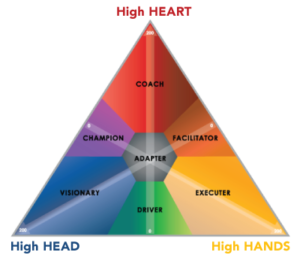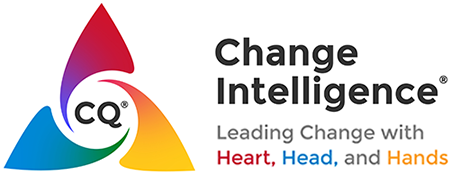During crisis we need to adapt to survive and thrive, and that starts with our own leadership agility. The definition of Change Intelligence®/CQ® is the awareness of our own style of leading change, and the ability to adapt it to be optimally effective across people and situations – which is even more important than ever in a crisis when old solutions no longer work and we need to pivot to new ways of working.
To lead through any crisis, or any change, we need to engage the Heart (focusing on people), enlighten the Head (focusing on purpose), and equip the Hands (focusing on process). Just like we each have a head and a heart and most of us have two hands, any of us can play each of these roles. However, we do tend to have a dominant style – our preferred go to style – that energizes us. Yet, in times of crisis, when so much is riding on us as leaders, we need to constantly adjust to cover all three bases, to ensure we are simultaneously caring for our teams, progressing toward the mission, and achieving results.

The CQ® System for Developing Change Intelligence® is a strengths-based model, and we can each leverage the strengths of each of the seven Change Leader Styles. Here is a quick tip for each style you can put into practice today – and below is a link to a recent webinar I conducted that offers more in-depth information to build deeper agility for the future:
- People who lead strongly from the Heart are motivating and supportive Coaches. Indeed, there’s no leader I’ve worked with since this crisis began who is not bringing their Heart to work more than ever before. Change – and especially this crisis – is an emotional journey, and it’s by helping people navigate this emotional journey through active listening and empathetic caring that we can all leverage our Coach strengths.
- Visionaries excel at the “why:” they lift people’s Heads-up, out of the muck and mire of the crisis, and help them reframe reality toward an inspiring future. Victor Frankl, psychiatrist and holocaust survivor, wrote “life is never made unbearable by circumstances, but only by lack of meaning and purpose.” Reframe the mission of your team in relation to this global crisis– hook and hinge to core values. Tell your hero’s journey and help people compose their own.
- Executers lead from the Hands are very tactically-oriented. During this crisis they will likely be focused on details of how to stay afloat and provide tangible tools to accomplish immediate objectives. That’s vital: every leader’s priority for the first 90 days of any crisis should be to help people reduce uncertainty, prioritize, and prepare a plan of action. As Joan Baez sang, “action is the antidote to despair.” A core Change Management 101 maxim is all about the power of the first step to build forward momentum.
- Many of us are combination styles. With a dual focus on Head and Heart, Champions relish motivating high performance teams to rally through this crisis to brighter horizons to come. What does research show is the #1 factor of high performing teams? Psychological safety. At this time when we are rightfully so focused on our physical safety, fostering a sense of psychological safety on our teams should be our dual focus. What does the research also show is the #1 way to foster psychological safety? Share challenges with each other. This crisis presents us with the opportunity to authentically invite people to share their challenges – and to role model leadership transparency in describing our own as well.
- Drivers get where they want to go (Head) and know how to get there (Hands) and therefore strive to drive forward with the strongest sense of urgency, which is so critical in this economic climate. Because of their sense of pragmatic bottom-line realism, Drivers tend to excel at plainly and clearly articulating the “what’s” through a crisis: “What is changing? What isn’t changing? What will continue?” Drivers provide a balance of agility and stability – Head and Hands – engine and anchor – solid ground for people when so much is shaken and shaky.
- Facilitators lead by being in the trenches with their teams, tackling both the emotional impact as well as taking on the workload to help people in a very hands-on, involved, practical manner. To channel your inner Facilitator, you can create a gratitude habit on your team – thank your team, thank individuals – concretely and specifically. This serves a dual purpose by building relationships as well as by getting results, because what gets noticed gets repeated. What you acknowledge others for helps clarify your expectations and focus people on important priorities and behaviors in these very confusing times.
- Adapters intuitively see the need for Head/Heart/Hands and can agily fill gaps, pivoting to adapt their approach to make sure people, purpose, and process considerations are covered. I love the expression, “The pessimist complains about the wind. The optimist expects it to change. The leader adjusts the sails.” We can each ask ourselves how we might reinvent to operate in our evolving reality – asking both why and why not – not just to think outside the box, but maybe even to bust the box.
I invite you to view the webinar, in which I describe each of the seven styles and their strengths more in-depth. I also share observations about how each style can struggle during this COVID-19 crisis, by overdoing their strengths and not “seeing” their leadership blind spots. Finally, I offer coaching strategies for each style – for each of us – to lead more effectively during this crisis, and beyond. Building our Change Intelligence® helps us humanize this crisis, and helps us become even more agile to lead through all the inevitable change to come.
